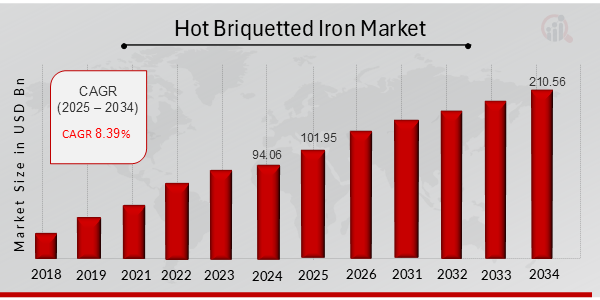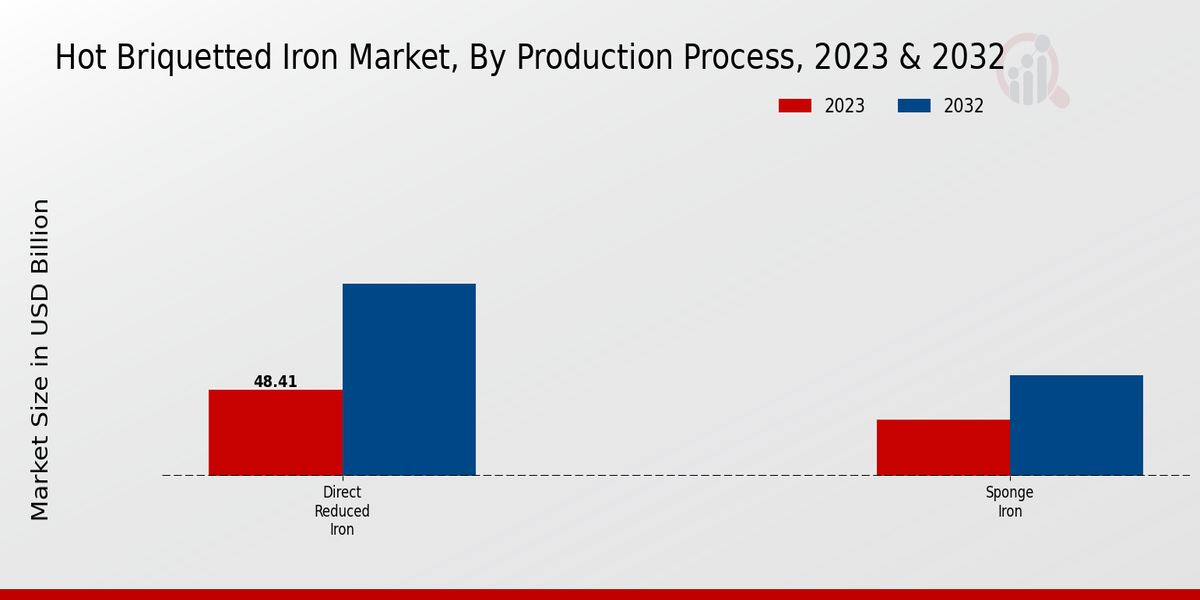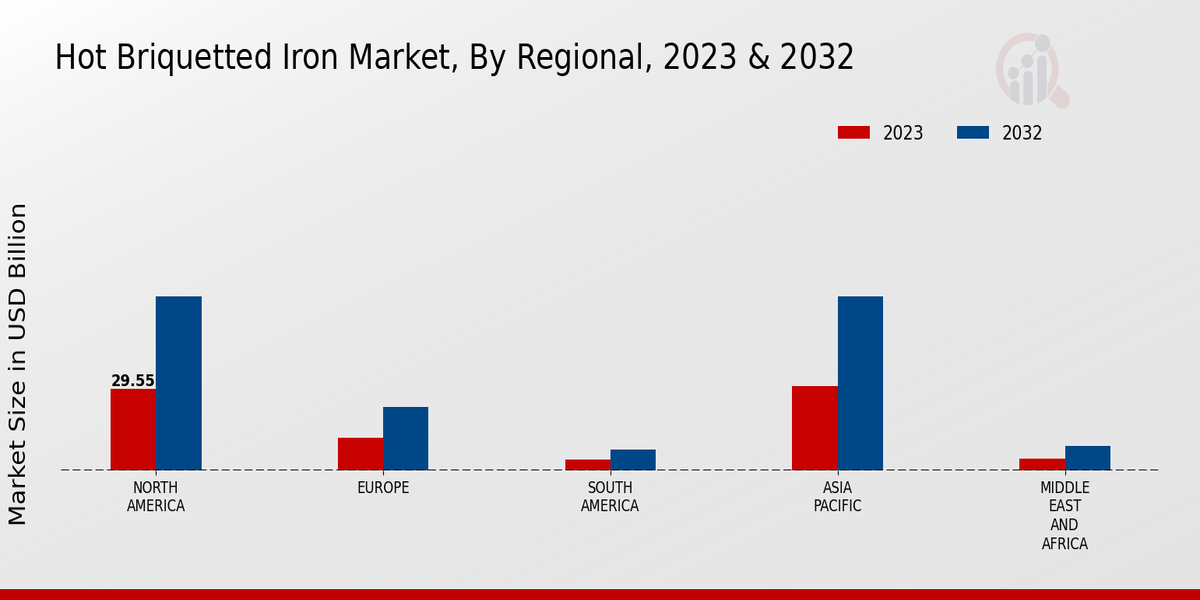Hot Briquetted Iron Market Overview:
As per MRFR analysis, the Hot Briquetted Iron Market Size was estimated at 94.06 (USD Billion) in 2024. The Hot Briquetted Iron Market Industry is expected to grow from 101.95 (USD Billion) in 2025 to 210.56 (USD Billion) till 2034, at a CAGR (growth rate) is expected to be around 8.39% during the forecast period (2025 - 2034).
Key Hot Briquetted Iron Market Trends Highlighted
Amidst a dynamic steelmaking landscape, the global Hot Briquetted Iron (HBI) market exhibits several key market trends. Surging demand for high-quality steel, coupled with a focus on environmental sustainability, is driving the adoption of HBI as a cost-effective and environmentally friendly alternative to traditional iron ore.Furthermore, the rising adoption of electric arc furnaces (EAFs) in steel production is creating significant opportunities for HBI. EAFs offer lower capital and operating costs, making them an attractive option for both developed and emerging markets. HBI is ideally suited for use in EAFs, as it requires minimal pretreatment and offers a high level of purity.Recent trends in the Hot Briquetted Iron market indicate a growing focus on innovation and technological advancements. Manufacturers are exploring new and improved production processes to enhance HBI quality and reduce production costs. Additionally, there is an increasing emphasis on developing localized HBI production facilities to cater to regional demand and reduce transportation expenses.

Source: Primary Research, Secondary Research, MRFR Database and Analyst Review
Hot Briquetted Iron Market Drivers
Rising Demand for Steel in Construction and Automotive Industries
The main consumers of steel are the construction and automotive industries, and the growing demand for these industries drives the growth of the Hot Briquetted Iron Market Industry. Steel is used in a variety of construction applications, such as structural components, reinforcing bars, and roofing. In the automotive industry, steel is used for body panels, frames, and engines. The demand for Hot Briquetted Iron Market Industry is expected to grow as the construction and automotive industries expand. The key factor influencing the growth of the Hot Briquetted Iron Market Industry is the increasing demand for new construction projects.Steel is essential for new construction projects in a variety of ways, including structural components, reinforcing bars, and roofing. In developing countries, the demand for new construction projects is expected to drive the growth of the Hot Briquetted Iron Market Industry. Another key factor driving the growth of the Hot Briquetted Iron Market Industry is the growing demand for new vehicles. Steel is used in a variety of automotive applications, such as body panels, frames, and engines.In developing countries, the demand for new vehicles is expected to drive the growth of the Hot Briquetted Iron Market Industry.
Increasing Adoption of Hot Briquetted Iron in Electric Arc Furnaces
Electric arc furnaces (EAFs) are becoming increasingly popular in the steel industry due to their environmental benefits and lower operating costs. Hot Briquetted Iron Market is well-suited for use in EAFs, as it has a high density and can be easily charged into the furnace. The increasing adoption of EAFs is expected to drive the growth of the Hot Briquetted Iron Market Industry.EAFs use electricity to melt scrap metal and produce steel. They are more environmentally friendly than traditional blast furnaces, as they produce less greenhouse gases and air pollution.EAFs also have lower operating costs than blast furnaces, as they do not require coke or other fuels. The increasing adoption of EAFs is expected to drive the growth of the Hot Briquetted Iron Market Industry, as the Hot Briquetted Iron Market is well-suited for use in these furnaces. Hot Briquetted Iron Market has a high density and can be easily charged into the furnace, making it an ideal feedstock for EAFs.
Government Policies Supporting the Steel Industry
Government policies that support the steel industry are another key driver of the growth of the Hot Briquetted Iron Market Industry. These policies include subsidies, tax breaks, and other incentives that encourage the production and use of steel. Government policies that support the steel industry are expected to continue to drive the growth of the Hot Briquetted Iron Market Industry in the coming years. Government policies that support the steel industry can take a variety of forms.Some governments provide subsidies to steel producers, while others offer tax breaks or other incentives. These policies can help to reduce the cost of producing steel, making it more affordable for consumers. Government policies that support the steel industry are expected to continue to drive the growth of the Hot Briquetted Iron Market Industry in the coming years. These policies can help to create a more favorable environment for the steel industry, making it more attractive for investors and businesses.
Hot Briquetted Iron Market Segment Insights:
Hot Briquetted Iron Market Production Process Insights
The Global Hot Briquetted Iron Market is segmented by Production Process into Direct Reduced Iron and Sponge Iron. Direct Reduced Iron (DRI) is a key raw material used in the production of steel. It's produced by reducing iron ore in a furnace using a reducing agent such as natural gas, coal, or hydrogen. DRI has a higher iron content and is more consistent in quality than traditional iron ore, making it an ideal feedstock for steelmaking. The global DRI market is expected to grow significantly in the coming years, driven by rising demand for steel from emerging economies.Sponge Iron is another important raw material used in steel production. It's produced by reducing iron ore in a kiln using a reducing agent such as coke or charcoal. Sponge iron has a lower iron content than DRI but is still a viable feedstock for steelmaking. The global sponge iron market is expected to grow modestly in the coming years as it faces competition from DRI and other alternative iron sources. The Production Process segment is a key driver of growth in the Global Hot Briquetted Iron Market. The increasing adoption of DRI and sponge iron in steelmaking is expected to boost demand for these materials in the coming years.The market is also expected to benefit from the growing demand for steel from emerging economies.

Source: Primary Research, Secondary Research, MRFR Database and Analyst Review
Hot Briquetted Iron Market End Use Insights
The Global Hot Briquetted Iron Market segmentation by End Use includes Steelmaking and Foundry. Steelmaking accounted for the largest revenue share in 2023, and it is expected to continue its dominance throughout the forecast period. The growth of the steelmaking segment can be attributed to the increasing demand for steel in various industries, such as construction, automotive, and manufacturing. The foundry segment is expected to witness a steady growth rate during the forecast period, owing to the rising demand for HBI in the production of castings and other metal products.
Hot Briquetted Iron Market Application Insights
The Global Hot Briquetted Iron Market is segmented by Application into Automotive, Construction, Industrial Machinery and others. The automotive segment is the largest application segment of the Global Hot Briquetted Iron Market, and it is expected to grow at a CAGR of 8.39% during the forecast period. Growing demand for Hot Briquetted Iron in the automotive industry is attributed to its superior properties such as high strength, durability, and cost-effectiveness. The construction segment is the second largest application segment of the Global Hot Briquetted Iron Market, and it is expected to grow at a CAGR of 8.1% during the forecast period.Increasing construction activities in emerging economies, such as China and India, is driving the growth of this segment. Industrial Machinery segment is the third largest application segment of the Global Hot Briquetted Iron Market and it is expected to grow at a CAGR of 7.9% during the forecast period. Growing demand for Hot Briquetted Iron in the manufacturing of industrial machinery is attributed to its exceptional strength-to-weight ratio and resistance to wear and tear.
Hot Briquetted Iron Market Grade Insights
The global Hot Briquetted Iron Market is segmented based on Grade into High Grade, Medium Grade, and Low Grade. Among these segments, the High-Grade segment held the largest market share of around 45% in 2023 and is expected to continue its dominance throughout the forecast period. The growth of the High Grade segment can be attributed to the increasing demand from the automotive industry, which requires high-quality Hot Briquetted Iron for the production of automotive components. The Medium Grade segment is expected to grow at a steady pace during the forecast period, owing to its increasing use in the construction industry.The Low Grade segment is expected to witness a moderate growth rate during the forecast period due to its limited applications in various industries
Hot Briquetted Iron Market Form Insights
The Global Hot Briquetted Iron Market segmentation by Form comprises Briquettes, Lumps, and Pellets. Among these, the Briquettes segment held the largest market share in 2023, accounting for approximately 45.2%. This dominance can be attributed to the high demand for briquettes in steelmaking processes, as they offer advantages such as uniform size, high density, and improved handling characteristics. The Lumps segment is anticipated to exhibit a steady growth rate over the forecast period, owing to the increasing use of lumps in the production of pig iron and other iron-based products.The Pellets segment, on the other hand, is expected to witness a moderate growth rate, primarily driven by its application in the production of Direct Reduced Iron (DRI). The Global Hot Briquetted Iron Market data indicates that the Briquettes segment is projected to reach a market valuation of around 95.45 billion USD by 2032, while the Lumps and Pellets segments are expected to reach 42.31 billion USD and 27.63 billion USD, respectively, by the end of the forecast period. These insights highlight the growing importance of different forms of hot briquetted iron in the global market.
Hot Briquetted Iron Market Regional Insights
The Global Hot Briquetted Iron Market is segmented into North America, Europe, APAC, South America, and MEA. Among these regions, APAC is expected to hold the largest market share in the coming years due to the increasing demand from the automotive and construction industries. The region is also home to some of the world's largest steel producers, which are investing heavily in HBI production. North America is another major market for HBI, with the region's automotive and construction industries driving demand. Europe is also a significant market for HBI, with the region's steel industry being a major consumer.

Source: Primary Research, Secondary Research, MRFR Database and Analyst Review
Hot Briquetted Iron Market Key Players And Competitive Insights:
Various significant players in the Hot Briquetted Iron Market industry are adopting various strategies such as new product launches, expansion, and acquisition to maintain their existence in the global market. Leading market players are going through intensive research and development to introduce new hot briquetted iron products to fulfill their clients’ demands. An increasing number of players in the Hot Briquetted Iron Market industry are forming partnerships and collaborations to use mutual benefits. One of the well-established players involved in the Global Hot Briquetted Iron Market is ArcelorMittal. The worldwide steel and mining company has a presence in the Hot Briquetted Iron Market, providing wide-ranging products. The company has a strong network of global production and sales facilities. ArcelorMittal is significantly investing in research and development to enhance the quality and performance of hot briquetted iron products. ArcelorMittal is a well-established player in the market due to its strong brand name, good reputation, wide spectrum of products, and global presence.Ferrexpo, the other major player in the Global Hot Briquetted Iron Market, is a Switzerland-based iron ore producer. The company has a huge iron ore mining and processing facility in Ukraine. Ferrexpo is one of the biggest hot briquetted iron producers in the world. The company has a strong focus on sustainability issues, and it produces hot briquetted iron in a highly responsible and sustainable way. Ferrexpo has a strong customer base, and it supplies raw materials to steel makers around the world. The company has a very sound production facility, focuses on sustainability issues and has a good customer base.
Key Companies in the Hot Briquetted Iron Market Include:
- Hyundai Steel
- Kobe Steel
- Sumitomo Metal Industries
- JSW Steel
- Shagang Group
- Nippon Steel
- ArcelorMittal
- Posco
- JFE Steel
- NLMK
- Metalloinvest
- Shougang Group
- Tata Steel
- Baosteel Group
Hot Briquetted Iron Market Industry Developments
The global Hot Briquetted Iron (HBI) market is projected to grow from USD 80.05 billion in 2023 to USD 165.39 billion by 2032, exhibiting a CAGR of 8.39% during the forecast period. Increasing demand for HBI in steelmaking, particularly in developing economies, is driving market growth. Government initiatives to promote sustainable steel production and reduce carbon emissions are further supporting HBI adoption. Recent news developments include the commissioning of new HBI plants in India and the Middle East, indicating the growing importance of HBI in meeting the increasing demand for high-quality steel.
Hot Briquetted Iron Market Segmentation Insights
Hot Briquetted Iron Market Production Process Outlook
- Direct Reduced Iron
- Sponge Iron
Hot Briquetted Iron Market End Use Outlook
Hot Briquetted Iron Market Application Outlook
- Automotive
- Construction
- Industrial Machinery
Hot Briquetted Iron Market Grade Outlook
- High Grade
- Medium Grade
- Low Grade
Hot Briquetted Iron Market Form Outlook
Hot Briquetted Iron Market Regional Outlook
- North America
- Europe
- South America
- Asia Pacific
- Middle East and Africa
| Report Attribute/Metric |
Details |
|
Market Size 2024
|
94.06 (USD Billion)
|
|
Market Size 2025
|
101.95 (USD Billion)
|
|
Market Size 2034
|
210.56 (USD Billion)
|
|
Compound Annual Growth Rate (CAGR)
|
8.39% (2025 - 2034)
|
|
Report Coverage
|
Revenue Forecast, Competitive Landscape, Growth Factors, and Trends
|
|
Base Year
|
2024
|
|
Market Forecast Period
|
2025 - 2034
|
|
Historical Data
|
2019 - 2023
|
| Market Forecast Units |
USD Billion |
| Key Companies Profiled |
Hyundai Steel, Kobe Steel, Sumitomo Metal Industries, JSW Steel, Shagang Group, Nippon Steel, ArcelorMittal, Posco, JFE Steel, NLMK, Metalloinvest, Shougang Group, Tata Steel, Baosteel Group |
| Segments Covered |
Production Process, End Use, Application, Grade, Form, Regional |
| Key Market Opportunities |
Increasing demand in construction Growing steel industry Rising infrastructure investments Expansion of automotive sector Surge in urbanization |
| Key Market Dynamics |
Rising steel production, increasing demand from electric arc furnaces, stringent environmental regulations, and technological advancements are growing the automotive industry. |
| Countries Covered |
North America, Europe, APAC, South America, MEA |
Frequently Asked Questions (FAQ) :
The Global Hot Briquetted Iron Market was valued at approximately USD 94.06 Billion in 2024 and is projected to grow at a CAGR of 8.39% over the forecast period, reaching a valuation of USD 210.56 Billion by the end of 2034.
The Asia-Pacific region is expected to dominate the Global Hot Briquetted Iron Market in the coming years due to the increasing demand from the steel industry in the region. China is the largest consumer of Hot Briquetted Iron in the world and is expected to continue to drive growth in the Asia-Pacific region.
Hot Briquetted Iron is primarily used in the production of steel. It is also used in the production of castings, iron powder, and other iron-based products
Some of the key competitors in the Global Hot Briquetted Iron Market include ArcelorMittal, Baosteel, JSW Steel, Kobe Steel, and Tata Steel.
The key factors driving the growth of the Global Hot Briquetted Iron Market include the increasing demand from the steel industry, the growing use of Hot Briquetted Iron in the production of castings and iron powder, and the increasing adoption of Hot Briquetted Iron in developing countries.
The key challenges facing the Global Hot Briquetted Iron Market include the volatility of raw material prices, the increasing cost of production, and environmental regulations.
The Global Hot Briquetted Iron Market is expected to grow at a CAGR of 8.39% over the next five years, reaching a valuation of USD 210.56 Billion by the end of 2034.
Some of the key trends in the Global Hot Briquetted Iron Market include the increasing adoption of Hot Briquetted Iron in the production of steel, the growing use of Hot Briquetted Iron in the production of castings and iron powder, and the increasing adoption of Hot Briquetted Iron in developing countries.
The COVID-19 pandemic had a negative impact on the Global Hot Briquetted Iron Market in 2020 and 2021, as the pandemic led to a decline in demand for steel and other iron-based products. However, the market is expected to recover in the coming years as the global economy recovers from the pandemic.
The future prospects for the Global Hot Briquetted Iron Market are positive, as the market is expected to grow at a steady pace over the next five years. The increasing demand from the steel industry, the growing use of Hot Briquetted Iron in the production of castings and iron powder, and the increasing adoption of Hot Briquetted Iron in developing countries are expected to drive the growth of the market in the coming years.

















